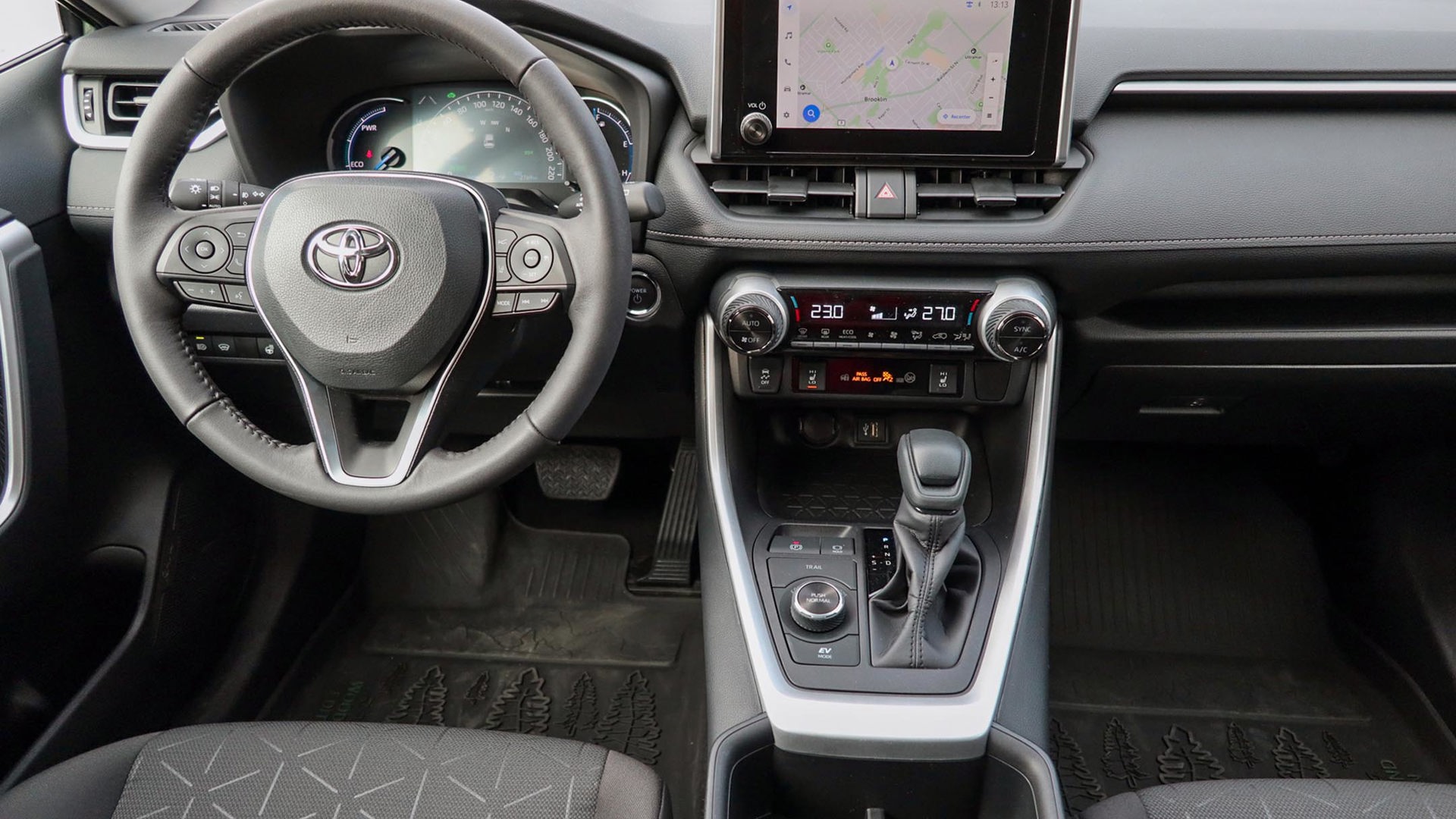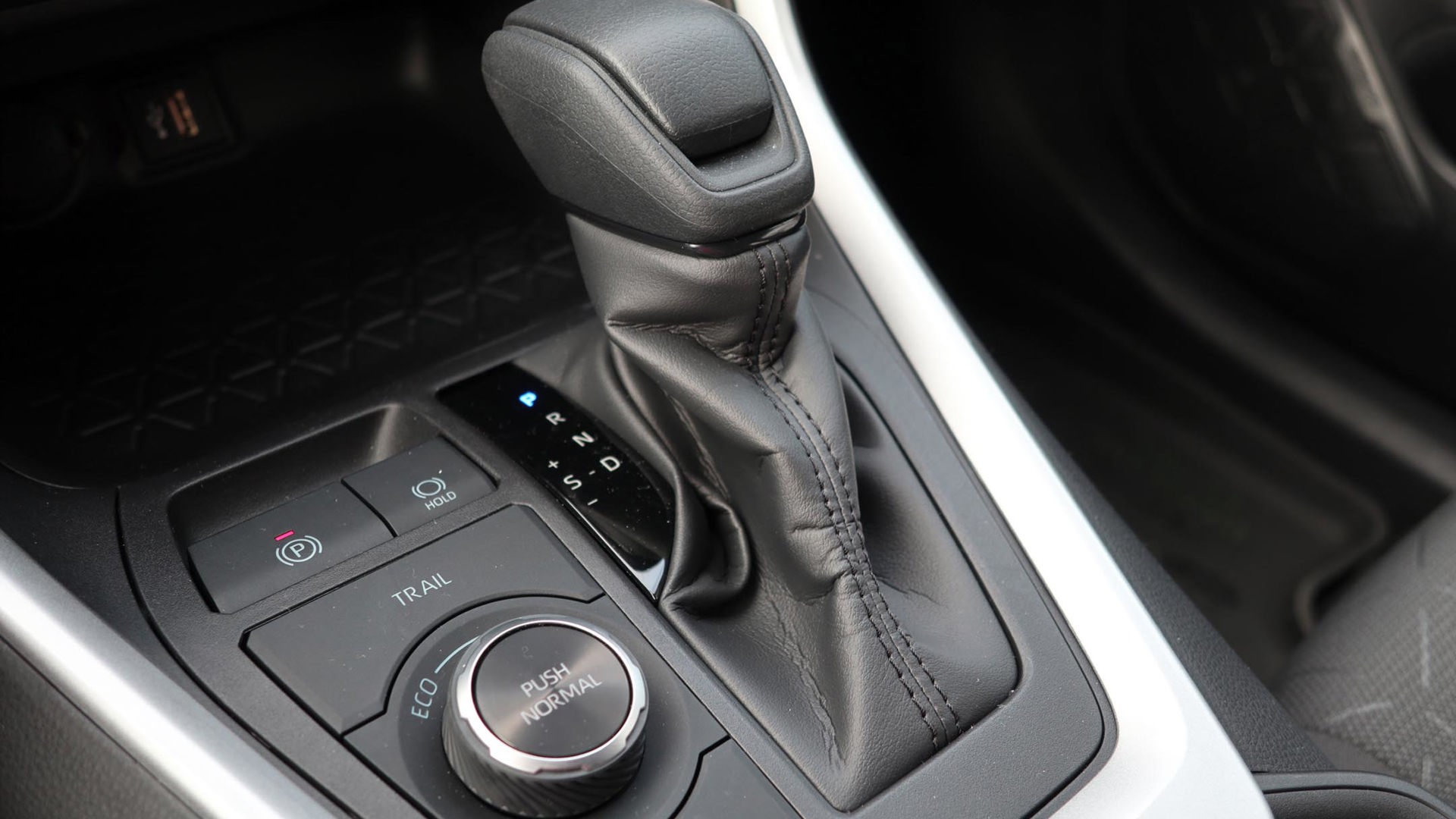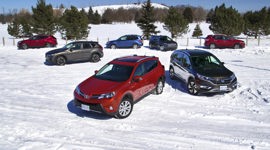 AutoTrader SCORE
AutoTrader SCORE
-
STYLING8/10
-
Safety9/10
-
PRACTICALITY8/10
-
USER-FRIENDLINESS8/10
-
FEATURES8/10
-
POWER8/10
-
COMFORT8/10
-
DRIVING FEEL8/10
-
FUEL ECONOMY9/10
-
VALUE8/10
The 2024 Toyota RAV4 Hybrid is the gas-electric version of the brand’s top-selling vehicle in Canada, alongside its gas-only sibling and the RAV4 Prime plug-in hybrid (PHEV).
It’s unchanged from the 2023 version save for a new shade of Army Green paint offered on specific trims. The RAV4 Hybrid comes in five trims, starting with the LE at $37,880, including a non-negotiable delivery fee of $1,930. I tested the next-up XLE, which starts at $40,980; it then goes to the SE, XSE, and finally the Limited at $48,880. My XLE tester had a Woodland package, plus that extra-charge Army Green paint, bringing it to $43,860 before taxes.
Styling: 8/10
While it’s a stretch to call the RAV4 handsome, it looks functional and hasn’t fallen prey to the brutally angled designs some SUVs have taken on. The Woodland trim includes taller roof rails with crossbars, LED fog lights, black exhaust tips, and 18-inch bronze wheels.
That functional look continues inside, with controls contained within a metallic-rimmed centre stack, and a layered-look dash that includes a cubby above the glovebox that mimics the upper dash panel above it. The LE, XLE, and SE trims come with an eight-inch touchscreen infotainment display, while the XSE with its optional Technology package and the Limited trim both have a 10.5-inch screen.
Safety: 9/10
The United States National Highway Traffic Safety Administration (NHTSA) crash-tested the RAV4 Hybrid and gave it the top five-star rating overall. At the Insurance Institute for Highway Safety (IIHS), last year’s 2023 RAV4 was named a Top Safety Pick. It scored the top “Good” in all legacy tests, but next-step-down “Acceptable” in the updated side crash test, which better simulates being struck by a larger SUV; and also in the updated moderate front overlap, which now assesses potential injury to a rear-seat passenger along with those in front.
Its “Acceptable” side test results mean it earned a Top Safety Pick for the 2023 version. The 2024 model will likely lose the designation (which hadn’t happened at the time of writing) because for 2024, only “Good” in that test will qualify vehicles for awards.
All trims include such driver-assist safety features as emergency front braking that recognizes pedestrians and oncoming traffic when you’re turning left, along with adaptive cruise control, automatic high-beam headlights, lane-keeping and centring assist, blind-spot monitoring with rear cross-traffic alert, and the back-up camera that’s mandatory on all new vehicles sold in Canada. The top Limited trim – and the XSE when outfitted with its Technology pack – exclusively add a panoramic camera and emergency rear braking.
Features: 8/10
The XLE tested here is one step up from the base LE, and that gives you some items missing on that entry trim, including push-button start, a power tailgate, power driver’s seat, heated steering wheel (all trims get heated front seats), cargo privacy cover, sunroof, and rain-sensing wipers. Both those trims have an eight-inch centre touchscreen with wireless Apple CarPlay and Android Auto connections, but the XLE further adds a three-year trial to remote connection services. Both can also be subscribed to a Google-based navigation and app system.
The Woodland package, available only with the XLE trim, adds an off-road-tuned suspension, 18-inch bronze wheels in place of the stock 17-inch rims, a 120-volt power outlet, roof rail crossbars, and all-season floor mats and cargo tray. Upper trims add such items as faux-leather upholstery, a hands-free tailgate, wireless charger, 10.5-inch centre screen, ventilated front seats, heated rear seats, and a power passenger seat.
User-Friendliness: 8/10
The RAV4’s controls are simple to use, with large knurled temperature dials that are easily operated with gloves. The heated seats are two-level toggles, the buttons on the steering wheel are intuitive, and the screen menus are straightforward. Visibility is good, and it’s easy to get in and out. All is good but for the front door pull-handles, which are too far forward and offer little leverage for closing the door, especially on a windy day.
Practicality: 8/10
The RAV4 is about mid-pack with its rivals in the compact hybrid SUV segment for its cargo compartment, with a volume of 1,059 L with the rear seats up. The Ford Escape Hybrid has only 974 L, and the Honda CR-V Hybrid has 1,028 L, but the Hyundai Tucson and Kia Sportage hybrids top it at 1,097 L and 1,121 L, respectively. The RAV4’s rear seats fold to carry longer cargo, although not completely flat; but the wide and long tailgate opening makes it very easy to get your items in and out. The RAV4 Hybrid can tow up to 794 kg (1,750 lb), at the upper end of its rivals for an unbraked trailer.
Comfort: 8/10
The RAV4 feels roomy even though its front- and rear legroom trails its competitors, while headroom is more generous than in most of those rivals. The seats, fabric-clad on the XLE, are comfortable and stay supportive on longer drives. But while certainly not unbearable, the RAV4 Hybrid’s ride was firm and there was a fair bit of road noise, especially when bumping over highway expansion joints.
Power: 8/10
Open the hood and you’ll find a 2.5L four-cylinder engine that, on its own, makes 176 hp and 163 lb-ft of torque. When working in conjunction with the hybrid electric motor, you get up to 219 hp. The system powers the front wheels through an automatic continuously variable transmission (CVT). All-wheel drive (AWD), standard on all trims, is achieved by another electric motor that powers the rear wheels fuel-free when needed. The hybrid battery charges through a front-mounted electric motor and through regenerative braking – capturing energy otherwise lost during deceleration – and the RAV4 Hybrid doesn’t get plugged in. (The RAV4 Prime does, which gives it some all-electric range in addition to its hybrid capabilities.)
The RAV4 Hybrid’s power is about average for the segment, and it does a good job for everyday driving. It can get noisy during hard acceleration, but it handles highway passing, and overall it’s smoother and better to drive than the gas-only RAV4.
Driving Feel: 8/10
The driving experience is on par with the power: the steering doesn’t have a lot of feel to it, but responds well; the vehicle corners smoothly; and it’s well-planted and confident on the highway. The turning circle is tight, making it easy to manoeuvre in tight places and parking spots. The selectable drive modes adjust the engine and transmission response, including for eco or sport. The Woodland adds a trail drive mode, which also adjusts the AWD, but consider this as a bit more traction on a cottage road rather than any serious trail.
The hybrid system automatically and almost seamlessly switches between gasoline, electricity, or a combination of both, depending on driving conditions. There’s an “EV Mode” button that’s intended to keep it on electric-only at low speeds, but the RAV4 does that on its own anyway, and the mode shuts off if you’re a touch too hard on the throttle.
Fuel Economy: 9/10
The RAV4 Hybrid is officially rated by Natural Resources Canada (NRCan) at 5.8 L/100 km in the city, 6.3 on the highway, and 6.0 in combined driving. The Woodland, with its knobbly tires and aerodynamically challenged roof racks, increases that to 6.4 L/100 km combined. In my week with it, in cold weather and with a lot of highway driving, where a hybrid doesn’t run on its battery as much, I averaged 7.5 L/100 km. By comparison, the gas-only RAV4 is rated 8.0 L/100 km in combined driving.
Those official figures are in line with its hybrid competitors, where the Honda CR-V and Hyundai Tucson rate at 6.4 combined; the Kia Sportage 6.2; and the Ford Escape 6.0.
Value: 8/10
The 2024 Toyota RAV4 Hybrid starts at $37,880 and runs to $48,880. Since it doesn’t plug in, it isn’t eligible for any provincial or federal rebates. The RAV4 Prime is, but it starts at $52,880.
The RAV4 Hybrid is competitive with rivals, all of which offer fewer trim choices than the Toyota. The 2024 Sportage runs from about $39,020 to $45,720; the Hyundai Tucson is $42,524; the Ford Escape in AWD is $45,544 to $49,974; and the Honda CR-V is $48,275, all prices including delivery.
The Verdict
While its pricier than its gasoline-only sibling, the 2024 Toyota RAV4 Hybrid offers a better driving experience and better fuel economy, along with a practical interior, simple controls, and numerous safety features. While it isn’t perfect, the RAV4 earns its title as the automaker’s top seller, and the hybrid version is definitely worth a look.
| Engine Displacement | 2.5L |
|---|---|
| Engine Cylinders | I4 |
| Peak Horsepower | 176 hp @ 5,700 rpm (engine only), 219 hp (hybrid net) |
| Peak Torque | 163 lb-ft @ 3,600 rpm |
| Fuel Economy | 6.1 / 6.8 / 6.4 L/100 km cty/hwy/cmb |
| Cargo Space | 1,059 / 1,977 L seats up/down |
| Model Tested | 2024 Toyota RAV4 Hybrid XLE |
| Base Price | $38,850 |
| A/C Tax | $100 |
| Destination Fee | $1,930 |
| Price as Tested | $44,300 |
|
Optional Equipment
$3,420 – Woodland Edition package, $2,880; Army Green paint with black roof, $540
|
|












































